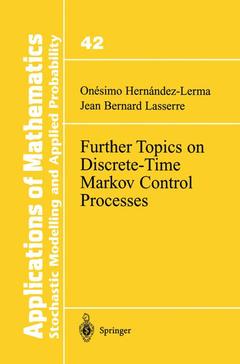Description
Further Topics on Discrete-Time Markov Control Processes, 1999
Stochastic Modelling and Applied Probability Series, Vol. 42
Authors: Hernandez-Lerma Onesimo, Lasserre Jean B.
Language: English
Subject for Further Topics on Discrete-Time Markov Control Processes:
Keywords
Markov; ergodicity; linear optimization; model; operations research; programming
105.49 €
In Print (Delivery period: 15 days).
Add to cart
Publication date: 10-2012
277 p. · 15.5x23.5 cm · Paperback
277 p. · 15.5x23.5 cm · Paperback
Description
/li>Contents
/li>
Devoted to a systematic exposition of some recent developments in the theory of discrete-time Markov control processes, the text is mainly confined to MCPs with Borel state and control spaces. Although the book follows on from the author's earlier work, an important feature of this volume is that it is self-contained and can thus be read independently of the first.
The control model studied is sufficiently general to include virtually all the usual discrete-time stochastic control models that appear in applications to engineering, economics, mathematical population processes, operations research, and management science.
The control model studied is sufficiently general to include virtually all the usual discrete-time stochastic control models that appear in applications to engineering, economics, mathematical population processes, operations research, and management science.
7 Ergodicity and Poisson’s Equation.- 7.1 Introduction.- 7.2 Weighted norms and signed kernels.- A. Weighted-norm spaces.- B. Signed kernels.- C. Contraction maps.- 7.3 Recurrence concepts.- A. Irreducibility and recurrence.- B. Invariant measures.- C. Conditions for irreducibility and recurrence.- D. w-Geometric ergodicity.- 7.4 Examples on w-geometric ergodicity.- 7.5 Poisson’s equation.- A. The multichain case.- B. The unichain P.E.- C. Examples.- 8 Discounted Dynamic Programming with Weighted Norms.- 8.1 Introduction.- 8.2 The control model and control policies.- 8.3 The optimality equation.- A. Assumptions.- B. The discounted-cost optimality equation.- C. The dynamic programming operator.- D. Proof of Theorem 8.3.6.- 8.4 Further analysis of value iteration.- A. Asymptotic discount optimality.- B. Estimates of VI convergence.- C. Rolling horizon procedures.- D. Forecast horizons and elimination of non-optimal actions.- 8.5 The weakly continuous case.- 8.6 Examples.- 8.7 Further remarks.- 9 The Expected Total Cost Criterion.- 9.1 Introduction.- 9.2 Preliminaries.- A. Extended real numbers.- B. Integrability.- 9.3 The expected total cost.- 9.4 Occupation measures.- A. Expected occupation measures.- B. The sufficiency problem.- 9.5 The optimality equation.- A. The optimality equation.- B. Optimality criteria.- C. Deterministic stationary policies.- 9.6 The transient case.- A. Transient models.- B. Optimality conditions.- C. Reduction to deterministic policies.- D. The policy iteration algorithm.- 10 Undiscounted Cost Criteria.- 10.1 Introduction.- A. Undiscounted criteria.- B. AC criteria.- C. Outline of the chapter.- 10.2 Preliminaries.- A. Assumptions.- B. Corollaries.- C. Discussion.- 10.3 From AC-optimality to undiscounted criteria.- A. The AC optimality inequality.- B. The AC optimality equation.- C. Uniqueness of the ACOE.- D. Bias-optimal policies.- E. Undiscounted criteria.- 10.4 Proof of Theorem 10.3.1.- A. Preliminary lemmas.- B. Completion of the proof.- 10.5 Proof of Theorem 10.3.6.- A. Proof of part (a).- B. Proof of part (b).- C. Policy iteration.- 10.6 Proof of Theorem 10.3.7.- 10.7 Proof of Theorem 10.3.10.- 10.8 Proof of Theorem 10.3.11.- 10.9 Examples.- 11 Sample Path Average Cost.- 11.1 Introduction.- A. Definitions.- B. Outline of the chapter.- 11.2 Preliminaries.- A. Positive Harris recurrence.- B. Limiting average variance.- 11.3 The w-geometrically ergodic case.- A. Optimality in IIDS.- B. Optimality in II.- C. Variance minimization.- D. Proof of Theorem 11.3.5.- E. Proof of Theorem 11.3.8.- 11.4 Strictly unbounded costs.- 11.5 Examples.- 12 The Linear Programming Approach.- 12.1 Introduction.- A. Outline of the chapter.- 12.2 Preliminaries.- A. Dual pairs of vector spaces.- B. Infinite linear programming.- C. Approximation of linear programs.- D. Tightness and invariant measures.- 12.3 Linear programs for the AC problem.- A. The linear programs.- B. Solvability of (P).- C. Absence of duality gap.- D. The Farkas alternative.- 12.4 Approximating sequences and strong duality.- A. Minimizing sequences for (P).- B. Maximizing sequences for (P*).- 12.5 Finite LP approximations.- A. Aggregation.- B. Aggregation-relaxation.- C. Aggregation-relaxion-inner approximations.- 12.6 Proof of Theorems 12.5.3, 12.5.5, 12.5.7.- References.- Abbreviations.- Glossary of notation.
© 2024 LAVOISIER S.A.S.




